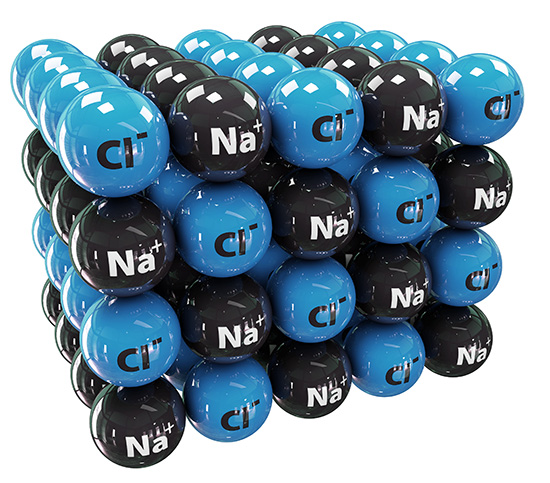
Chlorides
 OVERVIEW AND TREATMENT OPTIONS:
OVERVIEW AND TREATMENT OPTIONS:
Chloride is an ion present in all natural water. It is most commonly associated with salts (sodium chloride) and it’s concentration is very high in seawater. A person can’t detect the effects of chlorides (salty taste) in drinking water under 250 mg/L. High chloride levels can be aggressive and extremely corrosive to pipes and heating equipment. Although they are made of the same element, chlorides are not to be confused with chlorine. Chloride is mostly non-reactive therefore it doesn’t have the ability to disinfect water.
SOURCES
Occurs naturally from dissolved bedrock. Run-off from road salt, sewage contamination, or a water softener that’s not properly maintained can lead to elevated levels of chlorides. Sodium can occur in salts such as sodium chloride and potassium chloride, both of which dissolve easily when coming into contact with water. It is also widely used in industrial processing manufacturing chlorine, bleach, and fertilizers.

TESTING
Chlorides increase the electrical conductivity of water which, in turn, increases its corrosivity. If your drinking distribution system contains metal piping or fittings, then high levels of chlorides may cause leaching of heavy metals to occur. A sign of this may be etching on your glassware, spots on the glass shower door, or hard white scale seeping from your fixtures. If you suspect your water system to contain high amounts of chlorides, you can send a water sample to your local water treatment specialist who do water testing. If not able to find one in your area, CLICK HERE and we can help.
HEALTH CONCERNS
Chloride is not considered to be harmful to human health. High concentrations of chloride is associated with a high level of total dissolved solids (TDS) in the water supply. TDS can be very corrosive leaching other elements out of whatever it comes into contact with. this corrosion may lead to unsafe levels of copper and/or lead in the water. High concentrations of chloride can also be associated with high levels of sodium which can lead to high blood pressure, damaging the heart and arteries. Since chloride doesn’t pose a direct health risk, the EPA has not set health-based guidelines. Instead they have set a secondary maximum contaminant level (SMCL) for chloride of 250 mg/L (or ppm). This is the level of concentration where chloride would make the taste of the drinking water undesirable.
TREATMENT
Reverse Osmosis is the most common approach to removing chlorides from your drinking water. A POINT-OF-USE unit, which is often located near the kitchen sink, can be used to address just the drinking water and cooking water. For those where sodium levels are of a health concern, this system would assure a low salt intake. Water supplies with high chloride levels would require a POINT-OF-ENTRY unit to be installed. These systems require a large footprint depending on the approach to store the water.
BWS also brings a dynamic and creative approach to removing chlorides from your drinking supply. The VOLTEA DIENTRY is a tunable water purification system that is designed to remove total dissolved solids (TDS) from a variety of water sources, ranging from tap water and brackish groundwater to industrial process water. CapDI achieves this at a lower economic cost and reduced environmental impact than any other available technology
